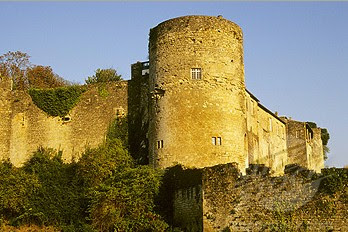by Katherine Ashe
Roger Bacon is considered to have introduced the formula and use of gunpowder to Europe in an article in his encyclopedic De Secretis Operibus Artis et Naturae. He illustrates a vase-shaped bronze vessel, and offers a practical compounding of what is now called black powder. How did this 13th century Oxford scholar and alchemist come to have the secret of China’s explosive substance and its use in artillery?
The trail of evidence is sometimes circumstantial but the facts are these:
Gunpowder and cannons were known in China by the twelfth century. The first recorded use in the West appears to have been by Islamic forces battling Christians on the Iberian Peninsula in the early thirteenth century. Arab trade with China at that time, with dhows sailing to Canton and junks sailing to Aden, was quite active, and most likely was the means of bringing the technology to Arabic domains. But cannons and gunpowder remained very secret weapons.
The Holy Roman Emperor Frederic II, known as the Stupor Mundi for his breadth of education and his insouciance toward Christianity, was educated by Arab scholars, attended by Arab physicians, and remained close to Arabic intellectuals and informants all his life.
At his siege of Milan 1238, Frederic’s army deployed a strange weapon that reportedly lofted missiles amid smoke and a thunderous roar. This same Milanese siege, at which Simon de Montfort was serving while in Italy (applying to the Vatican for the lifting of his wife’s vows as a nun), was commanded by Henry D’Urberville, on loan to Frederic from England and Simon’s former commander in Wales. D’Urberville would have seen Frederic’s secret weapon in operation.
D’Urberville was also Simon’s immediate predecessor as governor for Gascony, England’s dukedom in southern France. Incidentally, this is that same Henry d’Urberville whose empty tomb appears in Tess of the D’Urbervilles to inspire the country girl with her great ancestry. Henry died on crusade in the Holy Land, at King Louis’ battle at Mansourah.
Before going to govern Gascony for King Henry, Simon de Montfort served as ambassador for England at King Louis IX’s’ Court in Paris (1246-48.) During the time of his stay there, the university brought charges against a young alchemist named Roger Bacon who was annoying everyone by making foul smells in his room. The university authorities applied to King Louis to have him evicted.
Roger Bacon next turns up established at Oxford, which is then under the care of Robert Grosseteste’s protégé Adam Marsh. Grosseteste’s and Marsh’s existing letters to Simon show an extraordinary degree of familiarity with the Earl, they undoubtedly were his closest friends. It would seem likely that Simon was the link between Bacon and Oxford, and it was probably through his initial patronage that Bacon found a home there – on a bridge where his malodorous matter could be conveniently dumped into the river.
In his De Secretis Operibus Artis et Naturae, published in 1248, Bacon describes explosives and includes a drawing of a bronze vase-like vessel, the prototype of the European cannon.
Commissioned to suppress the Gascon lords’ rebelling against England’s rule, Simon de Montfort’s defeat of the mountain fortress of Mauleon in 1248 was so miraculously swift that it was attributed to supernatural agency, and brought about a fairly prompt surrender to the new governor. Might Simon have been using the cannon that Bacon describes?


The next record of what seems to have been the use of a cannon was in 1253, when King Henry was trying to raise funds from his English barons for a war – again to subdue Gascony. The king displayed to the lords steel arrows, quarrels, which had been lobbed at him amid thunderous noise from the roof of the fortress of La Reole — which previously had been supplied and used as headquarters by Montfort. The butt ends of the arrows were blackened as from a fiery explosion.

La Reole was built by Richard Coeur de Lion. A truly mighty fortress guarding the Garrone, it is notable also for its perfect stone likeness of Alfred E. Neuman, carved over the lintel of the door leading down from this great tower’s roof, and for the English ghosts who inhabit the top of the inner side of the long wall visible to the right of the tower. The soldiers were past their term of duty, murdered by the Piis faction as they slept on their barracks. I thank the Viort family, castellans for 500 years, for the tour they gave me of this castle that is their home.]
A cannon, very similar to the one Bacon illustrated in his writings of 1248, appears in De Nobilitatibus, Sapientii, et Prudentiis Regum, by Walter de Milemete in 1326. But the use of cannon and gunpowder by the English is not widely recognized until the Battle of Crecy in 1346.